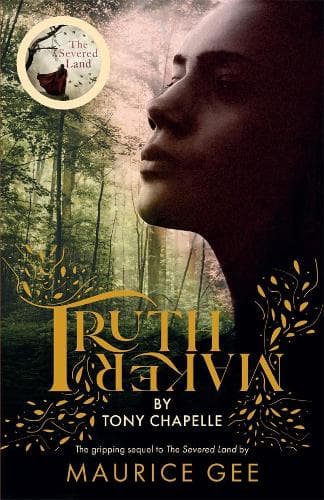Review: Truthmaker
Reviewed by Amber Black
Written by Tony Chapelle with the endorsement of Maurice Gee, Truthmaker picks up where Gee’s 2017 novella The Severed Land left off: shortly after ex-slave Fliss journeys back to the city of her birth, Galp, where a small number of colonist Families rule absolute and slavery, poverty and misfortune abound.
Following the hastening demise of The Old One, the imminent collapse of ‘the wall’—the invisible boundary which splits the severed land in two—has narrowly been prevented. Its existence is now dependent on the powers of Lorna—formerly known as The Nightingale, the disowned daughter of the family Despiner—whom Fliss was sent across the border to rescue from slavery, succeeding with help of new accomplice Minnie.
Alongside Lorna, Fliss and Minnie are now home safe, raising Minnie’s young daughter Maia whose father, the revolutionary Mutch, remains on the other side of the wall. All is well - village life is quiet, Maia is happy and healthy, and the trio seem to want for nothing. The Families seem to have ceased efforts to break through the wall, their cannons removed many months ago. And yet, Fliss and Lorna feel something in the air— a mutual uncertainty…
While visiting a neighbouring village, Fliss hears news of the Truthmaker: a “gifted young man spreading a new message of hope” who is rumoured to receive messages from The People themselves. Intrigued and eager to meet another with the ability to commune with The People, she travels back to the village to hear him speak. She is initially impressed by his good looks, his persuasive manner and his simple call for unity: One people, one land.
But soon it becomes clear that the Truthmaker is urging the destruction of the wall, announcing that the warring factions on the other side have made peace, and all are now living in complete harmony, regardless of race, gender or age. Fliss grows suspicious, troubled by the ease with which the villagers accept his tidings and fearful of the underlying implications of his claims.
Could it be that Truthmaker has received messages from The People that Lorna, chosen by the Old One himself, has not? Does this claim put Lorna in danger? Is it really possible that Galp, long-ravaged by the greed of the ruling Families, has reached peace in so short a time? And if Truthmaker lies, what is he hiding and what is at stake?
Once more, Fliss must set out to protect the wall with the help of her sister-in-arms Minnie. Hoping to reunite with Mutch and his underground network, they cross through the wall and head back towards Galp, equipped only with their wits— and the occasional guidance of the often vague and mystifying messages Fliss is able to receive through Lorna and The People.
A thoroughly enjoyable read, Chapelle’s continuation of Gee’s fictional world is as exciting, beautifully imagined and affecting as the original. The vivid descriptions of the dark and dangerous backstreets of Galp, teeming with thieves and jackers, mirror the inner tensions of our heroes Fliss and Minnie.
Beyond the immediate physical dangers, their experiences as enslaved people and their mere existence as women of colour, mean they must constantly be on guard—even in the presence of apparent allies. While they consider themselves sisters, at times they struggle to trust even each other.
The pursuit to uncover the ultimate purpose of the Truthmaker’s mission serves as a journey of self-discovery for Fliss. She must learn to trust her judgement and intuition, make sense of her hopes and desires, and begin to fully comprehend the world and her place within it, politically and personally. The history of this fictional land is complex and in the way of the best fantasy writing, it is often reminiscent of our own—in its depiction of the effects of colonisation, the danger of wide-spread misinformation and the enduring importance of knowledge and solidarity.
Full of brave, vibrant characters and unexpected twists, I’d recommend Truthmaker to anyone seeking an easy-going fantasy experience that delivers on adventure, authentic world-building and has a message of intersectionality at its core.
Reviewed by Amber Black
